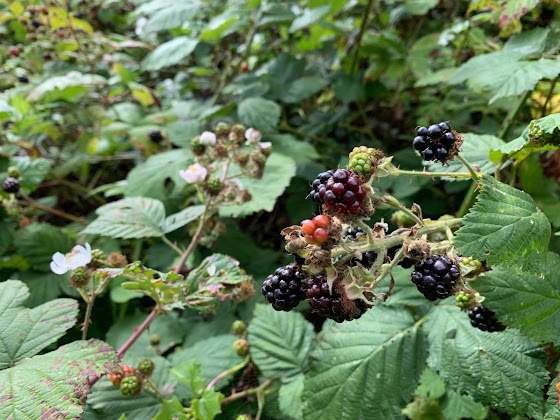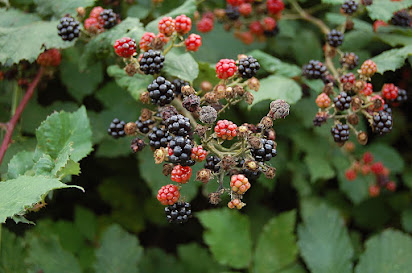Berry Expensive: How Blackberry Vines Can Degrade Your Property Value in Vancouver
Imagine stepping out into your lush garden, cup of coffee in hand, only to find your once-tidy green oasis rapidly turning into a wild jungle of brambles and thorns. What was once a backyard paradise has been overrun by uninvited guests - Himalayan blackberry vines.
While the promise of fresh, juicy berries might seem appealing, these invasive plants present a far more prickly issue. Not only do they wage war on native species and take over landscapes, but they also have a profound and often overlooked impact on your property's value.
Join us as we delve into the hidden costs of these thorny invaders, exploring how Himalayan blackberry vines can turn your real estate asset into a liability, and what you can do to reclaim your space and safeguard your property value.
Curb Appeal: One of the main ways blackberry vines can decrease property value is by reducing a property's curb appeal. A property overrun by blackberry vines can look unkempt and unattractive, which can deter potential buyers or lower their perception of the property's value.
Maintenance Costs: Blackberry vines require significant effort to control and remove, which can increase the maintenance costs for the property. Potential buyers may factor in these costs when considering a purchase, which could lead them to offer a lower price.
Structural Damage: Blackberry vines are robust and aggressive. Their roots can penetrate building foundations, walls, and paving, causing structural damage that can be costly to repair.
Habitat for Pests: Blackberry thickets can attract and harbor pests such as rodents and insects. If these pests infest homes or other structures on the property, it could require expensive pest control measures and repairs, which can lower property value.
Fire Risk: As previously mentioned, blackberry vines can be a fire hazard due to the amount of fuel they provide. This risk may increase insurance costs and deter potential buyers, particularly in regions prone to wildfires.
Access Issues: Dense, thorny thickets of blackberries can make parts of a property inaccessible, effectively reducing the usable space.
Legal Risks: If the blackberry vines spread to neighbouring properties, the owner may be held legally responsible for their control and removal. This potential liability could be a deterrent to potential buyers.
Blackberry thickets create an ideal environment for many rodents, including rats and mice, to thrive.
Shelter: The dense, thorny thickets of blackberry bushes provide a safe haven for rodents from predators. Their complex structure offers plenty of hiding spots and safe pathways for rodents to navigate. Rodents are also able to build nests within these thickets that are protected from the elements.
Food Source: Blackberry bushes bear fruit, which is a ready food source for many types of rodents. Even after the fruiting season, blackberry bushes can harbor other types of plant and insect life that rodents can feed on.
Breeding Ground: The safety and abundance of food provided by blackberry thickets can stimulate breeding among rodent populations. With plentiful resources, rodents are able to reproduce rapidly, leading to population booms.
Protection from Humans: Blackberry thickets are often impenetrable due to their dense growth and sharp thorns. This makes it difficult for humans to interfere with or remove rodent populations within these areas, thereby providing an additional layer of safety for rodents.
Due to these factors, an unchecked growth of blackberry vines can lead to an increase in the local rodent population, potentially leading to infestations in nearby homes and buildings.
Blackberry bushes are known for their ability to spread quickly and dominate landscapes.
Vegetative Propagation: Blackberry bushes can spread vegetatively, meaning they can create new plants from their roots, stems, and leaves. A process called "tip layering" allows new plants to form from the tips of the blackberry canes. When a cane tip touches the ground, it can grow roots and establish a new plant.
Seed Propagation: Blackberry bushes also spread through sexual reproduction. The blackberry fruits are consumed by various animals and birds. The seeds within the berries pass through the digestive system of these animals and are excreted in different locations, often far from the parent plant. The seeds can then germinate and establish new plants.
Robust Growth: Blackberries are extremely resilient and can thrive in a variety of conditions, allowing them to establish themselves in diverse environments. They prefer sunny, well-drained sites, but they can tolerate partial shade and a range of soil types.
Human Activity: In some cases, blackberry bushes can spread due to human activities. The berries are often planted for their fruit, but without proper management, they can quickly become invasive. Humans can also unintentionally spread the seeds when they stick to clothing or equipment.
These factors combined make blackberry bushes a challenging plant to control and prevent from spreading. Effective management requires consistent effort and often a combination of manual, mechanical, and chemical control methods.
Blackberry vines can cause significant harm to waterways in several ways:
Erosion Control: Native vegetation along waterways often plays a critical role in stabilizing soil and preventing erosion. When blackberry vines take over, they can crowd out this native vegetation. Although blackberry vines do have a thick network of roots, they are not as effective at soil stabilization, particularly in riparian areas. This can lead to increased soil erosion and the subsequent deposition of sediment in the waterway, which can disrupt aquatic habitats.
Water Quality: As blackberry vines replace native vegetation, the change in plant life can negatively impact the quality of the water. Many native plants play a role in filtering runoff before it enters a body of water. Without these plants, runoff may carry more pollutants into the waterway. Additionally, the decomposition of blackberry leaves and canes in the water can alter nutrient levels, potentially leading to issues such as algal blooms.
Habitat Alteration: Waterways are often rich in biodiversity, providing habitats for various plant and animal species. The takeover of blackberry vines can drastically alter these habitats, leading to a decrease in biodiversity. The dense thickets created by blackberry vines can also make the waterway inaccessible to animals that rely on it for drinking or bathing.
Stream Flow: In some cases, the extensive growth of blackberry vines can physically alter the flow of streams and rivers. The dense, impenetrable thickets can act as barriers that change the water's path, potentially leading to flooding and other issues.
Shading: Blackberry thickets can grow to substantial heights and, in doing so, may block sunlight from reaching the water surface. This lack of light can affect aquatic plants and the overall health of the waterway.
Thus, while blackberry vines might seem like harmless plants, their unchecked growth along waterways can lead to a host of environmental issues. It's crucial to control their spread and, where possible, replace them with native vegetation that supports the health and biodiversity of these waterways.
Blackberry thickets pose a substantial fire hazard, and here are a few reasons why:
Fuel Load: Blackberry thickets, with their dense growth of canes, leaves, and accumulated dead material, provide a large amount of fuel for fires. This biomass can easily catch fire and burn intensely, allowing a fire to spread rapidly.
Dead Material: As new canes grow, old canes die off but often remain within the thicket, creating a stockpile of dry, dead material. This dead material is highly combustible, particularly in dry conditions, and can quickly ignite.
Continuity of Fuel: Blackberry thickets often form continuous patches that can act as a bridge, allowing fire to spread across landscapes. They can enable a fire to move from the ground level to the canopy or from one area to another.
Increased Fire Intensity: The dense nature of blackberry thickets can result in a higher intensity fire. This can make the fire more challenging to control and increase the risk to nearby property and structures.
Impeding Fire Control Efforts: The dense and thorny nature of blackberry thickets can hinder fire control efforts. Firefighters can have difficulty accessing and moving through areas overgrown with blackberries, which can delay or impede firefighting efforts.
Because of these factors, it's important to manage and control the growth of blackberry vines, particularly in areas prone to wildfires. Regular removal of dead material, breaking up continuous patches, and maintaining a safe distance between blackberry thickets and buildings can help mitigate fire risks.
Throughout this comprehensive exploration, we've delved deeply into the detrimental impact of Himalayan blackberry vines on property value in Vancouver, Canada. It is clear that these insidious invaders, while producing tempting berries, bring along a series of problems that greatly affect the perceived and actual worth of properties.
From reducing curb appeal and increasing maintenance costs, to causing structural damage, attracting pests, enhancing fire risk, and generating potential legal issues, Himalayan blackberry vines undeniably represent a considerable menace to homeowners and real estate investors. Their relentless proliferation not only spoils the aesthetic and functional allure of properties but also raises serious questions about the long-term sustainability of these affected areas. The culmination of these effects manifests in a significant decrease in property values, signalling the harsh economic realities of this unchecked botanical invader.
However, the takeaway from this article shouldn't be solely one of alarm but one of prompt action as well. This understanding underscores the crucial need for a comprehensive, community-wide response. Homeowners, neighbourhood associations, and local governmental bodies should coordinate their efforts to control and eradicate these invasive plants. Investment in early detection, rapid response, regular management, and public education about the problem is key to mitigating the issue.
In essence, by addressing the Himalayan blackberry problem head-on, we aren't merely protecting property values in Vancouver; we're also preserving the overall environmental integrity of the region, and therein lies the true value of such efforts.
Expert Help:
Contact us for a Free Quote. We care intensely about the success of each project.
Fill out our contact form for a free in-person assessment: www.ascentyardcare.com/contact. Or contact us directly at 250-886-0338, jake@ascentyardcare.com
To learn more about our services visit our website at www.ascentyardcare.com




Comments
Post a Comment